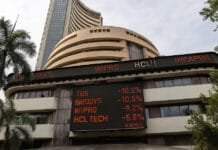India Faces Economic Challenges Amid Trump’s Tariffs and China’s Market Pressure
In recent times, India’s economic landscape has been navigating through turbulent waters. The dual impact of U.S. President Donald Trump’s imposition of tariffs and the escalating influence of China’s market dynamics has posed significant challenges. This article delves into the multifaceted repercussions of these developments on India’s economy and its future trajectory.
Stock Market Turbulence: A Historical Perspective
The Indian stock market has been experiencing a downward trend, with the Nifty 50 index on the brink of an unprecedented record. Should the decline persist through February, it would mark the fifth consecutive month of downturn, a phenomenon not witnessed since 1996. Historically, such prolonged slumps have been rare, with only two instances in the past 34 years. The most extended decline spanned from September 1994 to April 1995, during which the index plummeted by 31.4%. The current scenario, while concerning, has seen the Nifty drop by 11.7% since October, with a 3% decrease observed this month alone.
Foreign Institutional Investors: The Exodus
A significant factor contributing to this market downturn is the persistent sell-off by Foreign Institutional Investors (FIIs). Since October 2024, FIIs have offloaded shares worth over ₹2 lakh crore. The depreciation of the Indian rupee has rendered emerging markets less attractive, prompting these investors to withdraw their capital. This exodus has exerted additional pressure on the domestic stock markets, exacerbating the existing challenges.
Technical Analysis: Projections and Patterns
Technical analysts project that the Nifty could further descend to levels between 22,500 and 22,400. As long as the index remains below 22,850, selling pressure is anticipated to persist. The formation of a lower top-lower bottom pattern on daily charts indicates a bearish sentiment, suggesting that sellers are willing to offload at reduced prices amidst a bleak market outlook.
Global Trade Dynamics: The U.S.-China-India Nexus
The U.S.-China trade war has introduced an element of uncertainty for investors worldwide. President Trump’s recent executive order on reciprocal tariffs has raised concerns, especially for nations like India that impose higher tariffs on American goods. The potential for increased tariffs on Indian exports to the U.S. looms large, which could adversely affect sectors reliant on the American market.
Simultaneously, China’s stock market has been on an upward trajectory, intensifying competitive pressure on India. Foreign investors are reallocating funds from Indian markets to Chinese ones, attracted by the latter’s robust performance. Since October 2024, India’s market capitalization has diminished by $1 trillion, while China’s has surged by $2 trillion. The Hang Seng Index alone has witnessed an 18.7% increase in just one month, contrasting sharply with the 1.55% decline in the Nifty during the same period.
Strategic Shifts: ‘Sell India, Buy China’ Trend
Analysts observe a growing trend of ‘Sell India, Buy China’ among investors. This shift is attributed to the relative affordability of Chinese stocks and the economic stimulus package announced by China in September 2024. The package encompasses policy support, regulatory relaxations, and measures to bolster Foreign Institutional Investor sentiment. These initiatives have rejuvenated Chinese markets, making them more appealing to global investors.
Investor Guidance: Navigating the Uncertainty
In light of these developments, investors are advised to exercise caution and adopt a strategic approach. Emphasis should be placed on investing in fundamentally strong companies with a minimum annual profit of ₹100 crore. Diversification across sectors less susceptible to global trade tensions can also mitigate risks. Additionally, with the fiscal year drawing to a close, investors should consider tax harvesting strategies. This involves selling underperforming stocks to offset gains and reduce taxable income, thereby optimizing the investment portfolio.
Charting the Path Forward
India stands at a critical juncture, confronting challenges emanating from international trade policies and shifting global investment patterns. While the current scenario presents hurdles, it also offers an opportunity for introspection and recalibration. By focusing on strengthening domestic economic fundamentals, fostering innovation, and enhancing competitiveness, India can navigate these challenges and pave the way for sustained economic growth.
Disclaimer: The insights presented in this analysis are based on current market conditions and expert opinions. Investors are encouraged to conduct thorough research and consult certified financial advisors before making investment decisions, as market dynamics are subject to rapid changes.
















